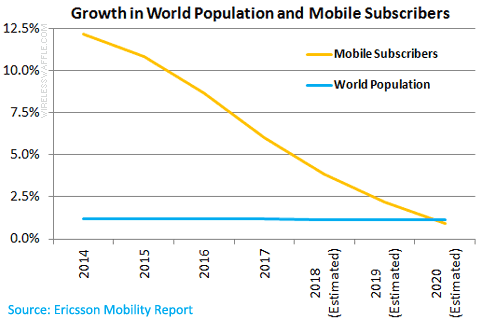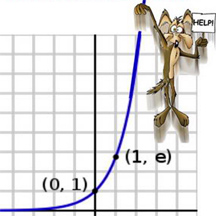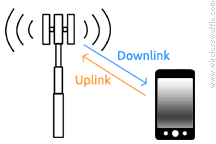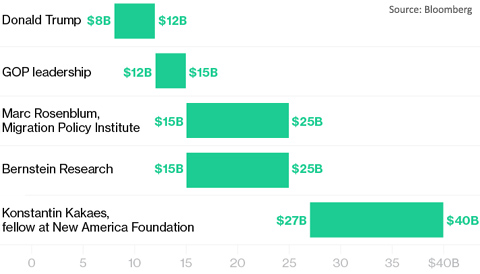Thursday 21 June, 2018, 17:42 - Spectrum Management
Posted by Administrator
Posted by Administrator
 Wireless Waffle regularly peruse published data on all manner of radio and related topics to bring you our often orthogonal analyses of various subjects leading to outcomes that others may not have considered. It is with exactly that kind of hat on, that we were looking at the figures produced by Ericsson in its annual Mobility Report. In the report, they give the number of subscribers with a mobile connection, which in 2017 stood at 5.3 billion, up from 5 billion in 2016. This does not include 'machine' subscriptions, nor multiple subscriptions by the same person (i.e. where someone has a phone and a tablet computer, or a work phone and a personal phone) and therefore represents just the number of actual people with a mobile connection.
Wireless Waffle regularly peruse published data on all manner of radio and related topics to bring you our often orthogonal analyses of various subjects leading to outcomes that others may not have considered. It is with exactly that kind of hat on, that we were looking at the figures produced by Ericsson in its annual Mobility Report. In the report, they give the number of subscribers with a mobile connection, which in 2017 stood at 5.3 billion, up from 5 billion in 2016. This does not include 'machine' subscriptions, nor multiple subscriptions by the same person (i.e. where someone has a phone and a tablet computer, or a work phone and a personal phone) and therefore represents just the number of actual people with a mobile connection.The interesting fact from amongst these statistics is that the growth in new mobile subscribers is slowing, and using forecasting based on the 'it fits a nice curve so is probably right' school of highly advanced bistromathics, by 2020, new additions will have fallen to just 1% more than in the previous year reaching around 5.7 billion. World population growth is forecast to be around 1.15% in the same year reaching around 7.8 billion.

Digging slightly deeper into the figures, what becomes clear is that during 2020, the number of new mobile subscribers will be less than the number of new people on the planet. In 2019, the number of people without a mobile subscription is estimated (by Wireless Waffle) to be 2.08 billion. In 2020 the number of people without a mobile subscription is estimated to be 2.11 billion, or 30 million more.
This is an interesting conclusion. It means that within 2 years, the number of people on the Earth without a mobile subscription will begin to grow. The number of those without access to mobile telecommunications will get bigger. Or put in other terms, the digital divide (between the 'haves' and the 'have nots') will get worse. This appears to be down to two main factors:
 Coverage: Although coverage is still increasing in many countries, it is slowing down. In particular, coverage in rural or remote areas is not changing significantly, as it proves increasingly costly to reach these hard to get to places.
Coverage: Although coverage is still increasing in many countries, it is slowing down. In particular, coverage in rural or remote areas is not changing significantly, as it proves increasingly costly to reach these hard to get to places.- Price: The cost of mobile subscriptions is no longer falling significantly as operators fight to recoup their investments in 3G and 4G. As such, those who can afford a connection already have one, and other than general growth trends increasing the income of the lowest paid, those who cannot afford a connection are unlikely to be able to do so any time soon.
At the same time as the digital divide is set to grow, mobile operators and mobile equipment vendors are hell-bent on introducing new technologies including 5G and millimetre wave. Both these technologies will provide bucket loads of capacity and throughput, but cell sizes are generally going to be limited to a few hundred metres at most, and capacity will be focussed on dense urban areas where there is profit to be made selling such services to data hungry consumers. They are also not cheap and nor will they be incorporated into low-end mobile handsets. The upshot of this is that 5G and millimetre wave technologies will not improve coverage, indeed they will excentuate the urban/rural divide, and they will also do nothing to make services more cost-effective, they will exacurbate the problem.
There is no simple answer to the problems of coverage and price,
 other than mobile operators taking different investment decisions based not necessarily on commercial return, but on providing a public service. Of course they are commercial companies and thus neither obliged nor motivated to become public servants, which is why it might be time for governments to step in. This has happened already in many countries when it comes to investment in fibre, in that a market failure has been identified, and governments have stepped in to fund fibre roll-out to otherwise uneconomical places. The fibre has then been offered on a wholesale basis to anyone who wished to use it.
other than mobile operators taking different investment decisions based not necessarily on commercial return, but on providing a public service. Of course they are commercial companies and thus neither obliged nor motivated to become public servants, which is why it might be time for governments to step in. This has happened already in many countries when it comes to investment in fibre, in that a market failure has been identified, and governments have stepped in to fund fibre roll-out to otherwise uneconomical places. The fibre has then been offered on a wholesale basis to anyone who wished to use it.Maybe the same is now needed for wireless services. The 700 MHz band, for example, is a good candidate to provide rural and remote area coverage at reasonable cost. Instead of auctioning all of the band off to the highest bidder, governments could reserve some (or all) of the band for a national wholesale operator whose target is rural/remote coverage and sell this back to the other operators on a wholesale basis (they could even share the spectrum on a geographic basis with the main operators who could use it in urban/suburban areas). The governments of Mexico and Rwanda are already doing just this, and it makes sense: building just one network in hard to get to places, is, even using basic bistromathics, around four times cheaper than building one network per operator (assuming there are four operators).
One thing that will not solve the problem, is finding yet more radio spectrum for mobile services. Introducing new mobile bands such as those touted at 26 GHz and above, will do absolutely nothing to improve the situation. Today's problem is no longer capacity, it is coverage and price. And spectrum is not the solution, revised government thinking just might be.
1 comment
( 751 views )
| permalink
| 



 ( 3 / 40308 )
( 3 / 40308 )




 ( 3 / 40308 )
( 3 / 40308 )
So many organisations and individuals involved in telecommunications continue to use the term 'exponential' to describe the growth in internet traffic, whether carried on fixed networks, or on wireless. Reports such as the ITU.M... forecast continued exponential growth until 2030 and there are numerous publications that cite growth following an exponential curve. But (with the possible expansion of the universe), nothing grows forever, let alone exponentially.
Let's consider the implications of exponential growth in internet data traffic. According to various sources, the amount of data transferred over the internet in 2018 will reach 1 Zettabyte (or 8x10²¹ bits). If growth continues exponentially at current rates (e.g. around a 50% year-on-year increase), the following things will happen: This is to say nothing of the electrical power requirements. Based on current future expectations of the energy required to transfer a bit of data (around 1 picoJoule per bit), by around 2080 we would need every single Watt of power generated on the planet Earth today to keep the Internet's lights on (let alone the problems of the sizes of batteries that would be needed in mobile devices). By 2113, we would need to capture every milliWatt of power that the Sun emits in order to power the Internet (in essence building a Dyson sphere). Slowly but surely the exponential growth in Internet traffic would begin to consume the whole universe.
This is to say nothing of the electrical power requirements. Based on current future expectations of the energy required to transfer a bit of data (around 1 picoJoule per bit), by around 2080 we would need every single Watt of power generated on the planet Earth today to keep the Internet's lights on (let alone the problems of the sizes of batteries that would be needed in mobile devices). By 2113, we would need to capture every milliWatt of power that the Sun emits in order to power the Internet (in essence building a Dyson sphere). Slowly but surely the exponential growth in Internet traffic would begin to consume the whole universe.
It is therefore to be hoped that the universe is actually infinite and continues to expand (though opinions on this are divided), otherwise it will run out of power before our insatiable demand for watching cat videos is finally sated.
 You might wonder what all this has got to do with radio spectrum, as there's always a Wireless Waffle angle on that topic. The simple fact is that although all the energy on the planet may be consumed keeping the Internet going, the amount of radio spectrum required to deliver the speed of connection necessary to transfer that much data will consume all available frequencies far before 2080. This is, of course, the desired goal of the mobile industry!
You might wonder what all this has got to do with radio spectrum, as there's always a Wireless Waffle angle on that topic. The simple fact is that although all the energy on the planet may be consumed keeping the Internet going, the amount of radio spectrum required to deliver the speed of connection necessary to transfer that much data will consume all available frequencies far before 2080. This is, of course, the desired goal of the mobile industry!
As Professor Albert Bartlett of the University of Colorado so aptly puts it:
Let's consider the implications of exponential growth in internet data traffic. According to various sources, the amount of data transferred over the internet in 2018 will reach 1 Zettabyte (or 8x10²¹ bits). If growth continues exponentially at current rates (e.g. around a 50% year-on-year increase), the following things will happen:
 By 2161, the number of bits of data transferred across the internet will equal the number of atoms in a human body.
By 2161, the number of bits of data transferred across the internet will equal the number of atoms in a human body.- By 2229, the number of bits of data transferred across the internet will equal the number of atoms in the planet Earth.
- By 2270, the number of bits of data transferred across the internet will equal the number of atoms in the Solar system.
- By 2329, the number of bits of data transferred across the internet will equal the number of atoms in the Milky Way galaxy (excluding dark matter).
 This is to say nothing of the electrical power requirements. Based on current future expectations of the energy required to transfer a bit of data (around 1 picoJoule per bit), by around 2080 we would need every single Watt of power generated on the planet Earth today to keep the Internet's lights on (let alone the problems of the sizes of batteries that would be needed in mobile devices). By 2113, we would need to capture every milliWatt of power that the Sun emits in order to power the Internet (in essence building a Dyson sphere). Slowly but surely the exponential growth in Internet traffic would begin to consume the whole universe.
This is to say nothing of the electrical power requirements. Based on current future expectations of the energy required to transfer a bit of data (around 1 picoJoule per bit), by around 2080 we would need every single Watt of power generated on the planet Earth today to keep the Internet's lights on (let alone the problems of the sizes of batteries that would be needed in mobile devices). By 2113, we would need to capture every milliWatt of power that the Sun emits in order to power the Internet (in essence building a Dyson sphere). Slowly but surely the exponential growth in Internet traffic would begin to consume the whole universe. It is therefore to be hoped that the universe is actually infinite and continues to expand (though opinions on this are divided), otherwise it will run out of power before our insatiable demand for watching cat videos is finally sated.
 You might wonder what all this has got to do with radio spectrum, as there's always a Wireless Waffle angle on that topic. The simple fact is that although all the energy on the planet may be consumed keeping the Internet going, the amount of radio spectrum required to deliver the speed of connection necessary to transfer that much data will consume all available frequencies far before 2080. This is, of course, the desired goal of the mobile industry!
You might wonder what all this has got to do with radio spectrum, as there's always a Wireless Waffle angle on that topic. The simple fact is that although all the energy on the planet may be consumed keeping the Internet going, the amount of radio spectrum required to deliver the speed of connection necessary to transfer that much data will consume all available frequencies far before 2080. This is, of course, the desired goal of the mobile industry!As Professor Albert Bartlett of the University of Colorado so aptly puts it:
The greatest shortcoming of the human race is our inability to understand the exponential function.
Since his election as President of the United States, one of Donald Trump's key programmes has been the construction of a wall along the border with Mexico. Many people believe that the purpose of such a wall is to reduce illegal immigration along the border and to stop goods being illegally transported between the two countries without clearing the necessary customs.
 Wireless Waffle has discovered, however, that the reason for the construction of the wall is nothing to do with immigration or customs but is needed to prevent transmissions from mobile base stations using the 700 MHz band in Mexico from interfering with mobile base stations in the 700 MHz band in the USA.
Wireless Waffle has discovered, however, that the reason for the construction of the wall is nothing to do with immigration or customs but is needed to prevent transmissions from mobile base stations using the 700 MHz band in Mexico from interfering with mobile base stations in the 700 MHz band in the USA.
It is often said that radio signals do not respect international borders: signals from one country do not abruptly stop when they reach an arbitrary line on a map. As such, signals from mobile base stations in border areas are prone to cause interference to base stations on the opposite side of the border. Several European countries have reached an agreement (known as the HCM Agreement) which defines how much cross-border 'overspill' is permitted.
In general when signals cross borders, the use of the radio spectrum either side of the border is similar, that is to say that if the frequencies are used on one side for base station transmissions, it will be used on the other side for the same purpose. For example, if the signals from one country's mobile base stations are roughly the same strength along the border as those from its neighbour, and assuming that a mobile handset will latch onto the strongest signal, as it passes from one country to the next, it will automatically select the network for the country in which it is located.
 The worst case situation is where the transmitters on one side of the border (the 'downlink') which are typically 1000 Watts or more for a mobile base station are on the same frequencies as the receivers on the other (the 'uplink') which are trying to receive signals from mobile handsets with 1 Watt of power who are several miles away. This is akin to having someone in one country shouting directly into the ear of someone standing next to them who is simulatneously trying to hear one of their own residents whispering to them from a great distance. No manner of technological development will solve this problem and hence neighbouring countries try and avoid this happening.
The worst case situation is where the transmitters on one side of the border (the 'downlink') which are typically 1000 Watts or more for a mobile base station are on the same frequencies as the receivers on the other (the 'uplink') which are trying to receive signals from mobile handsets with 1 Watt of power who are several miles away. This is akin to having someone in one country shouting directly into the ear of someone standing next to them who is simulatneously trying to hear one of their own residents whispering to them from a great distance. No manner of technological development will solve this problem and hence neighbouring countries try and avoid this happening.
Between the US and Mexico in the 700 MHz band, however, this situation arises. The diagram below shows how the frequencies in this mobile band are used in either country. A downlink (mobile base station transmission) on the same frequency as an uplink (mobile base station receive) will cause exactly the kind of problems identified above.

So... the base stations in the 'lower 700 MHz band' in the USA will cause immense interference to the base stations in Mexico operating at the upper end of the Mexican 700 MHz band, and the base stations in Mexico will cause immense interference to the 'upper 700 MHz band' base stations in the USA.
 There is no straightforward solution to this problem, other than one or other country adopting the same frequency plan as its neighbour. As both countries already have services operating in the bands, this is beyond unlikely. The only way to overcome such a problem is therefore to try and stop signals from one side of the border reaching the other side. The laws of physics dictate that the only way to do this is to build a barrier that is impervious to radio signals, such as, for example, a tall metallic wall (or one with metal running up the inside). Metal boxes known as Faraday cages are used in laboratories (and sci-fi movies) to perform just this task.
There is no straightforward solution to this problem, other than one or other country adopting the same frequency plan as its neighbour. As both countries already have services operating in the bands, this is beyond unlikely. The only way to overcome such a problem is therefore to try and stop signals from one side of the border reaching the other side. The laws of physics dictate that the only way to do this is to build a barrier that is impervious to radio signals, such as, for example, a tall metallic wall (or one with metal running up the inside). Metal boxes known as Faraday cages are used in laboratories (and sci-fi movies) to perform just this task.

The 700 MHz band was sold at auction in the USA for US$19 billion in 2008. Estimates of the cost of the wall vary, but the mean value is around US$20 billion. This is no co-incidence. Having paid US$19 billion for the spectrum in the 700 MHz band, the US operators have a reasonable expectation that they can use the frequencies without undue interference and thus a 'Faraday Wall' is necessary. As long as Mr Trump can build it for less than US$19 billion, the operators will be happy, and the Federal Reserve will still have made a small profit on the sale of the spectrum. Win-win as they say.
 Wireless Waffle has discovered, however, that the reason for the construction of the wall is nothing to do with immigration or customs but is needed to prevent transmissions from mobile base stations using the 700 MHz band in Mexico from interfering with mobile base stations in the 700 MHz band in the USA.
Wireless Waffle has discovered, however, that the reason for the construction of the wall is nothing to do with immigration or customs but is needed to prevent transmissions from mobile base stations using the 700 MHz band in Mexico from interfering with mobile base stations in the 700 MHz band in the USA.It is often said that radio signals do not respect international borders: signals from one country do not abruptly stop when they reach an arbitrary line on a map. As such, signals from mobile base stations in border areas are prone to cause interference to base stations on the opposite side of the border. Several European countries have reached an agreement (known as the HCM Agreement) which defines how much cross-border 'overspill' is permitted.
In general when signals cross borders, the use of the radio spectrum either side of the border is similar, that is to say that if the frequencies are used on one side for base station transmissions, it will be used on the other side for the same purpose. For example, if the signals from one country's mobile base stations are roughly the same strength along the border as those from its neighbour, and assuming that a mobile handset will latch onto the strongest signal, as it passes from one country to the next, it will automatically select the network for the country in which it is located.
 The worst case situation is where the transmitters on one side of the border (the 'downlink') which are typically 1000 Watts or more for a mobile base station are on the same frequencies as the receivers on the other (the 'uplink') which are trying to receive signals from mobile handsets with 1 Watt of power who are several miles away. This is akin to having someone in one country shouting directly into the ear of someone standing next to them who is simulatneously trying to hear one of their own residents whispering to them from a great distance. No manner of technological development will solve this problem and hence neighbouring countries try and avoid this happening.
The worst case situation is where the transmitters on one side of the border (the 'downlink') which are typically 1000 Watts or more for a mobile base station are on the same frequencies as the receivers on the other (the 'uplink') which are trying to receive signals from mobile handsets with 1 Watt of power who are several miles away. This is akin to having someone in one country shouting directly into the ear of someone standing next to them who is simulatneously trying to hear one of their own residents whispering to them from a great distance. No manner of technological development will solve this problem and hence neighbouring countries try and avoid this happening. Between the US and Mexico in the 700 MHz band, however, this situation arises. The diagram below shows how the frequencies in this mobile band are used in either country. A downlink (mobile base station transmission) on the same frequency as an uplink (mobile base station receive) will cause exactly the kind of problems identified above.

So... the base stations in the 'lower 700 MHz band' in the USA will cause immense interference to the base stations in Mexico operating at the upper end of the Mexican 700 MHz band, and the base stations in Mexico will cause immense interference to the 'upper 700 MHz band' base stations in the USA.
 There is no straightforward solution to this problem, other than one or other country adopting the same frequency plan as its neighbour. As both countries already have services operating in the bands, this is beyond unlikely. The only way to overcome such a problem is therefore to try and stop signals from one side of the border reaching the other side. The laws of physics dictate that the only way to do this is to build a barrier that is impervious to radio signals, such as, for example, a tall metallic wall (or one with metal running up the inside). Metal boxes known as Faraday cages are used in laboratories (and sci-fi movies) to perform just this task.
There is no straightforward solution to this problem, other than one or other country adopting the same frequency plan as its neighbour. As both countries already have services operating in the bands, this is beyond unlikely. The only way to overcome such a problem is therefore to try and stop signals from one side of the border reaching the other side. The laws of physics dictate that the only way to do this is to build a barrier that is impervious to radio signals, such as, for example, a tall metallic wall (or one with metal running up the inside). Metal boxes known as Faraday cages are used in laboratories (and sci-fi movies) to perform just this task. 
The 700 MHz band was sold at auction in the USA for US$19 billion in 2008. Estimates of the cost of the wall vary, but the mean value is around US$20 billion. This is no co-incidence. Having paid US$19 billion for the spectrum in the 700 MHz band, the US operators have a reasonable expectation that they can use the frequencies without undue interference and thus a 'Faraday Wall' is necessary. As long as Mr Trump can build it for less than US$19 billion, the operators will be happy, and the Federal Reserve will still have made a small profit on the sale of the spectrum. Win-win as they say.
Saturday 27 January, 2018, 09:04 - Spectrum Management, Much Ado About Nothing
Posted by Administrator
It seems that we, here at Wireless Waffle are having a bit of a spate of 'told you so' type events at the moment. Last month we spotted that Vodafone had been rapped over the knuckles for their crafty roaming fee shenanigans. Now we have spotted that Ofcom have been called out to assist drivers who couldn't lock or unlock their cars due to radio interference.Posted by Administrator
 On various occasions we have discussed how straightforward and relatively widespread the jamming of the frequencies used for your car keyfob is. Last time we discussed this it was because some miscreants had latched onto the idea and were stopping people locking their cars so that they could easily break in (more like stroll in) and take whatever they found in the glove compartments, foot wells and boots of the rich and not-so-rich.
On various occasions we have discussed how straightforward and relatively widespread the jamming of the frequencies used for your car keyfob is. Last time we discussed this it was because some miscreants had latched onto the idea and were stopping people locking their cars so that they could easily break in (more like stroll in) and take whatever they found in the glove compartments, foot wells and boots of the rich and not-so-rich. The Ofcom story is even more worrying as it suggests that jamming these devices is far easier than even we though possible. In addition to the car keyfobs we are so keen on discussing, the same frequency range (433 MHz) is also used for a wide variety of other wireless devices including wireless doorbells. These devices are relatively low power (10 milliWatts) and the idea is that they shouldn't interfere with each other as the range of transmission is very small. It seems, however, that a button on one such doorbell got stuck in the 'on' position, meaning it was constantly transmitting. This was enough to stop people in the vacinity locking and unlocking their cars. Thankfully, the brave Ofcom engineers were able to track down the problem and sanity was restored. Hurrah for Ofcom!
The Ofcom story is even more worrying as it suggests that jamming these devices is far easier than even we though possible. In addition to the car keyfobs we are so keen on discussing, the same frequency range (433 MHz) is also used for a wide variety of other wireless devices including wireless doorbells. These devices are relatively low power (10 milliWatts) and the idea is that they shouldn't interfere with each other as the range of transmission is very small. It seems, however, that a button on one such doorbell got stuck in the 'on' position, meaning it was constantly transmitting. This was enough to stop people in the vacinity locking and unlocking their cars. Thankfully, the brave Ofcom engineers were able to track down the problem and sanity was restored. Hurrah for Ofcom!Far be it for us to opine on the implications of this, but taking the earlier example from the BBC in which miscreants were jamming car locks but haven't Ofcom just provided these folk (and others with a similar inclination) with a simple, cheap and undetectable means of achieving the same outcome?
Just get hold of the push-button part of a wireless doorbell, put this in your pocket, and wander around a car park where posh cars park (maybe even buy a hi-viz jacket so it looks as if you are meant to be there). If it's a supermarket car park, collect a few trollies whilst you're waiting. When a particularly rich looking owner appears, go and stand close to their car and as they get out and get ready to press the button on their key to lock it, activate the wireless doorbell button. 'Hey presto', the car won't lock and you will be able to help yourself to their Gucci loafers and other luxury goodies.
From a radio spectrum management and perhaps more specifically a Wireless Telegraphy Act perspective, no law has been broken. From a Theft Act perspective, however, you still stand to be charged (or sit, depending on the layout of the court room).
Thanks Ofcom!

Posted using my gold-plated iPhone X, whilst wearing Gucci loafers and sipping Bollinger RD '85 on my luxury yacht moored in Saint Tropez with my 3 Aston Martins parked alongside.

